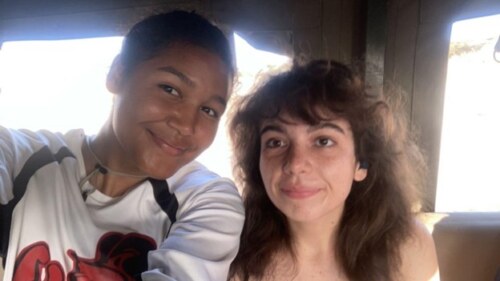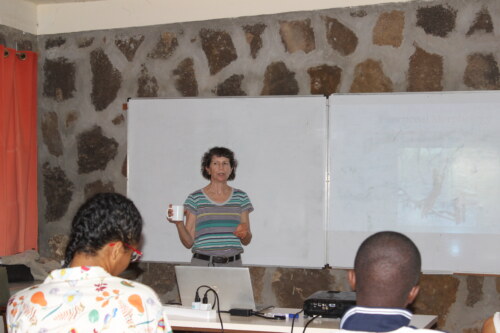This week’s blog comes from Simone and Sedona, and we’ll be talking about our experiences during the first week of the vertebrate paleontology course, which is also the field school’s first week while staying at TBI Ileret on the east side of Lake Turkana! Simone is a recent graduate from Boston University with a degree in Archaeology, and Sedona is a current senior studying Economics at Case Western Reserve University in Ohio.

A picture of Sedona, left, and Simone, right.
We arrived at Ileret on a very hot Saturday, having taken a short flight across the lake from the TBI Turkwel research station. Having a life-long fascination with paleontology, Simone was practically bouncing off the walls as we arrived for the course, since this module is a childhood dream come true, but we both were also interested in exploring the Ileret campus, to know how the logistics of a research institution could be managed in such a remote location. We and our fellow students settled in quickly, getting acquainted with the local camp dogs Jacinta and Bruno, as well as the Ileret staff, and also bombarding our new professor, Dr. Ellen Miller with questions about paleontological fieldwork.
It turns out that the East African Rift Valley is an ideal place to do paleontology. First because prehistoric rivers and lakes have provided ideal conditions for the fossilization of bones and the preservation of ancient skeletons, second because tectonic activity continues to expose fossils, and third because volcanic eruptions periodically coat the landscape with ash that gets buried and is ideal for chronometric dating. Preservation here is incredible, so we knew we were in for a real treat with this course.

Dr. Ellen Miller introducing the students to the vertebrate paleontology course.
On our first day with Dr Miller, we learned about the history of life on Earth, which included a brief lab project where we used toilet paper to create a timeline that contextualized the period of time humans have been on our planet. It quickly became apparent that our has been but a brief blip in our planet’s history.
That night, the previous month of monotonous scorching desert heat was broken by a surprise thunderstorm. While we were quite grateful for the cool breeze that came before it, we quickly realized that a handful of our fellow students had earlier in the day moved their beds outdoors onto the veranda to catch an extra breeze – and were about to get soaked. Of course, as a team that had already been together for a month, we all quickly jumped into action to helping our friends move their beds back indoors and into the dry.
Because of the storm, the next morning we were all exhausted and slightly soggy. We had our second lecture about phylogeny, or the categorization of species’ relationships. This included a spirited debate about two opposing schools of thought on the subject. One is cladistics, which groups organisms based on their shared common ancestry. The other is evolutionary systematics, which seeks to determine the degree of relatedness between different species, as well as their evolutionary relationships. We then followed this up with a lab task that involved creating a phylogeny for a fictional lineage of creatures going back 19 million years. Through this exercise, we were given the opportunity to identify the ancestral and derived features of these little creatures, and place them on a giant cladogram based on their derived characteristics.
The next three days were spent learning about functional morphology and anatomy, as we sought to understand why animals look the way that they do, and how to identify the various bones that paleontologists find in the fossil record.
We spent most of our lab time examining modern bones of different animals found in East Africa, including hyena, gerenuk, zebra, warthog, galago, and monkeys, so that we could understand how morphology differs between animals that belong to different taxonomic groups. Extra time was spent examining different kinds of teeth and to be able to identify the different types. These include the tall hypsodont teeth of grazers like zebras, the flat generalized bunodont teeth of warthogs and primates, the crescent shaped selenodont teeth of the gerenuk, and the intimidating carnassial pair found in the mouths of carnivores. Tooth enamel is the hardest part of the mammalian body, and is therefore the most likely part to become preserve in the fossil record. This makes teeth one of the most important anatomical features to know as a paleontologist.
On Saturday, we wrapped up week one with a bone exam, testing our knowledge of what we had learned about bones. With only a minute at each station, where we had to identify each bone, and determine which side of the body it was on, and the order it belonged to, the exam was a fitting end to a week of intensive study.





